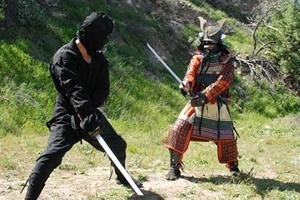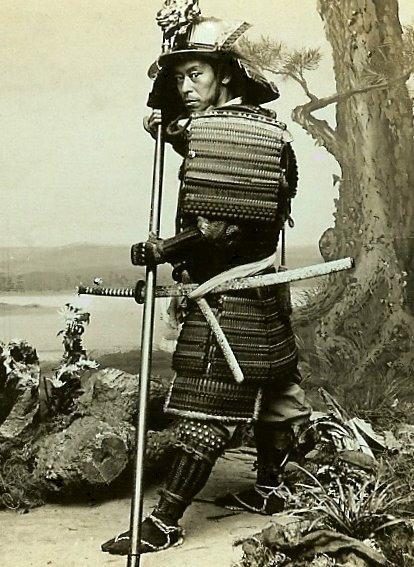Like this post? Help us by sharing it!
Two of the most evocative images of historical Japan are the ninja and the samurai. We’ve all heard of them, but what do you actually know about these famous assassins and warriors? It’s time for the epic showdown of the ninja and the samurai!
First of all, who were they?
Samurai 侍 (usually called “bushi” or “buke” in Japanese) were the military nobility of Japan. They lived during a time when the Emperor of Japan was little more than a ceremonial figure, and the country was actually ruled by a shogun, or military general.
The shogun presided over a bunch of powerful clans, called daimyo, each of which controlled its own small portion of the country and hired samurai to act as its guards and warriors.

Samurai were not only fierce warriors, but they followed strict codes of honour and combat. During the long peace of the Edo Period (1603-1868), samurai gradually lost their military function and expanded their roles as courtiers, bureaucrats and administrators. The samurai class was eventually abolished in the Meiji Reforms of the 19th century, after enjoying hundreds of years of power and influence.

Ninja 忍者 (known as “shinobi”忍び in Japan) were essentially ye olde equivalent of secret agents, whose role involved espionage, sabotage, infiltration and assassination. Where the samurai adhered obdurately to their principles, the ninja were a very different story, using covert means to achieve their ends. Just like the samurai, they were employed by powerful clans to do their dirty work.
Not much about them is known for certain, but what we do know is that the modern-day image of a ninja is a far cry from the historical reality – as Kotaku explains in this interesting blog post. Our current conception of the ninja has been reinforced over time – not only by western movies like American Ninja, but also by Japanese media and folklore.
What did they look like?
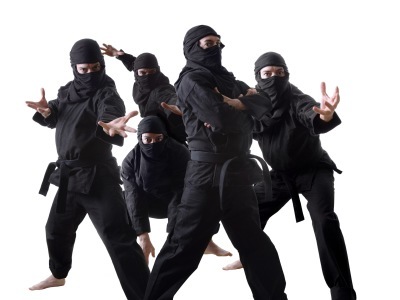
All this sounds exciting, but as Matt Alt points out in his book Ninja Attack: True Tales of Assassins, Samurai and Outlaws, being a ninja was probably much more about gathering information than assassinating people in the dead of night. Most often, ninja would be dressed inconspicuously – as farmers or priests for example – so that they could act as scouts and observe the enemy without being rumbled. Come to think of it, the idea of some guy running about the place dressed in black does seem kind of conspicuous…

We have the painter Hokusai to thank for the first ever image of the ninja dressed all in black, which may have been based on the garb of stage hands in the Japanese theatre – who wore dark colours so as not to be seen on set.
Samurai, on the other hand, looked awesome and imposing in their badass armour, which grew to have a ceremonial as well as protective function as the role of the samurai changed. The fact that samurai no longer had to charge into battle at a moment’s notice during the Edo Period meant that some armour became exaggerated, even to the point of being a little ridiculous – like this fine set, belonging to the Ii clan of Hikone.
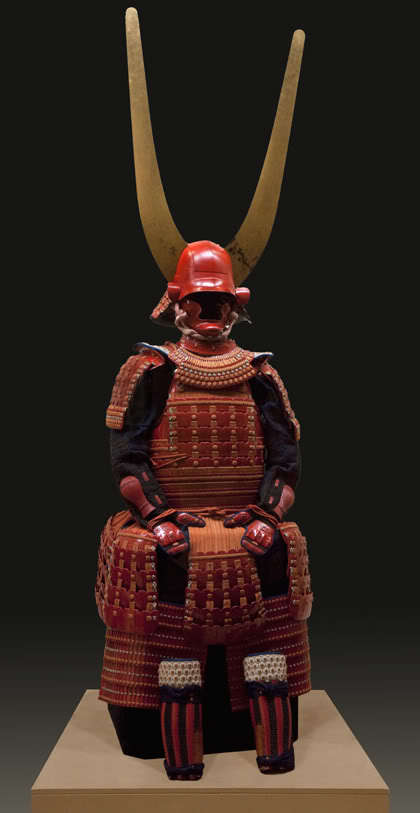
When were they around?
The concept of the samurai began to emerge during the mid-Heian Period (794-1185). Sneaky ninja predecessors probably existed as far back as the late Heian Period too. However, the shinobi, as a specially trained group of mercenaries from the villages of Iga and Koga, only appeared in the fifteenth century – making them a good five hundred years younger than the samurai.
The ninja, born out of a demand for fighters who were willing to do dishonourable deeds, and reliant on political unrest and war for their trade, faded into obscurity after the unification of Japan in the seventeenth century. The samurai, meanwhile, adapted their role in society and endured much longer.
What was their philosophy?
The rules by which the samurai governed their lives are known as Bushido – which is basically the Japanese version of chivalry. This code of honour, influenced by Confucianism, Shinto and Zen Buddhism, introduced an element of wisdom and peace to the violent life of the samurai.
To sum it up, the seven virtues of Bushido are rectitude (or righteousness), courage, benevolence, respect, honesty, honour and loyalty. Mastery of the martial arts and a frugal lifestyle were also highly important to the samurai, and they endeavoured to follow all these precepts to the letter in every aspect of their lives. Honestly, nothing could be more different from the underhand dealings of the ninja.
Ninja philosophy had its roots in Chinese military philosophy – and was focussed much less on values, and much more on kicking butt.
There are three main texts from which we get most of our knowledge of ninja, called the Ninpiden (1655), the Bansenshukai (1675) and the Shoninki (1681). These address things like how to disguise oneself, how to break into houses and gather information, how to lay false trails, and some observations on human nature and emotions.
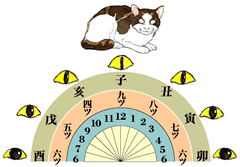
Just some of the awesome tactics that ninja are reported to have used are telling the time by observing the dilation of cats’ pupils, and carrying around a box of crickets with them to disguise their footsteps. Whether these are actually true is anyone’s guess.
What kind of weapons did they use?
Samurai pretty much relied on their swords for weaponry. These ranged from the katana (long sword) to the wakizashi (short sword) and the tanto (dagger). Sometimes they also used a kama (a sickle-like weapon) – but without a doubt, the most awesome samurai weapon is the war fan.

Thought fans were just for the ladies? Well, you were wrong. A tessen was a folding fan with outer spokes made of pointy iron – or sometimes, a solid club made to look like a fan. The tessen could be used for attacks, fending off arrows and darts, as a throwing weapon and even (rather amusingly) as a swimming aid. Crafty.

Because ninja relied on ambush and unorthodox tactics, whereas samurai generally fought honourably (face-to-face), ninja could use a much greater variety of weapons.
While ninja probably used swords too, they also used things like red pepper or iron filings to temporarily blind enemies; a scary-looking chain and sickle contraption called a kusarigama; farming tools that could be easily disguised as, well, gardening tools; darts, spikes, knives, shuriken throwing stars, bows, smoke bombs, poison, cane swords, acid-spurting tubes (apparently) and even a variety of explosives.
Besides these, they carried tools such as grappling hooks, chisels, hammers, drills, picks and saws (all of which could also be used as weapons), and inflatable skins with breathing tubes to allow them to stay underwater for extended periods of time. Obviously they didn’t carry all this at the same time – the Bansenshukai, one of the ninja texts, states that “a successful ninja is one who uses but one tool for multiple tasks”.
So who would have won in a fight?
In an honourable fight? Maybe the samurai would have had a chance. But considering the huge array of tricks up ninja sleeves (plus purported superhuman abilities such as invisibility, shapeshifting, walking on water, the summoning of animals and control over the elements – which were probably true, let’s face it), the ninja would probably have got him in the end.



